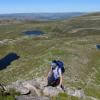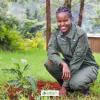GIS, or Geographic Information Systems, play a crucial role in nature conservation. Every day, mapping and spatial analysis are aiding conservation decisions, protected areas designation, habitat management on reserves and monitoring of wildlife populations, to name but a few examples. Want to learn more about how remote sensing is used in conservation? Check out the first two episodes of this season of Tech Tutors, where our Tutors answer the questions How do I use open source remote sensing data to monitor fishing? and How do I access and visualise open source remote sensing data in Google Earth Engine?
You can also check out our Virtual Meetup Archive for a range of panels that overlap with Remote Sensing & GIS topics.
- 0 Resources
- 0 Discussions
- 6 Groups
- 0 Resources
- 0 Discussions
- 3 Groups
- @KC
- | She/her
Graduate Research Assistant at SDSU, Conservation officer for Department of Forest and Park Services, Bhutan. Works on carnivores, applied quantitative ecologist
- 0 Resources
- 0 Discussions
- 7 Groups
- 0 Resources
- 0 Discussions
- 1 Groups
- 0 Resources
- 0 Discussions
- 11 Groups
- 0 Resources
- 4 Discussions
- 2 Groups
Wildlife conservationist
- 0 Resources
- 0 Discussions
- 11 Groups
Data has been my passion and i enjoy working with data while bringing value to the business. Data engineer with 7+ years of experience Eager to support with expert analytical skills to advance the companys business operations and strategic initiative.
- 0 Resources
- 0 Discussions
- 9 Groups
- @kbubnicki
- | he/his
Ecologist, data scientist, and programmer with over 13 years of professional experience. Open source and Linux enthusiast. Researcher at the Mammal Research Institute, Polish Academy of Sciences, and CEO of the Open Science Conservation Fund.
- 0 Resources
- 0 Discussions
- 5 Groups
Fauna & Flora
Remote Sensing Scientist
- 2 Resources
- 1 Discussions
- 6 Groups
- @silvanasitayiari
- | she/her
- 0 Resources
- 0 Discussions
- 7 Groups
Adventure Scientists is a 501(c)3 nonprofit organization based in Bozeman, MT that equips scientists and researchers with high-quality data collected from the outdoors that are crucial to addressing environmental challenges around the world.
- 0 Resources
- 0 Discussions
- 16 Groups
Watch our interview with pioneering young Tanzanian vulture researcher Vainess Laizer! Her research investigating the breeding success of white-backed vultures in the western corridor of the Serengeti ecosystem using...
16 April 2024
ZSL is looking for an enthusiastic research scientist to join the multidisciplinary team and help deliver a project in Wales to better understand the ecology of tope sharks (Galeus galeus) in North Cardigan Bay and the...
9 April 2024
WWF is looking for consultant(s) with expertise in spatial data mapping and analysis.
19 March 2024
The Smithsonian’s National Zoo and Conservation Biology Institute (SNZCBI) is seeking two postdoctoral fellows to engage more directly with identifying conservation metrics for vertebrate communities and populations.
14 March 2024
The Max Planck Institute of Animal Behavior at its sites in Constance and Radolfzell offers an international, interdisciplinary, and collaborative environment that opens up unique research opportunities. The goal of our...
13 March 2024
Texas A&M is seeking applicants for a fully funded Ph.D. assistantship to begin a long-term study on collared peccary (also known as javelina) ecology in southern Texas.
13 March 2024
Emerging trends for Nature-Based Solutions project assessments
8 March 2024
Join us to help prevent biodiversity loss! Understory is hiring a postdoc to lead R&D Development on generalizing Computer Vision models for vegetation identification across space/time/phenotypes.
29 February 2024
Is there really a sustainability data deficiency? We don’t think so.
29 February 2024
Join the Luxembourg Institute of Science and Technology (LIST) in pioneering environmental and ecological monitoring! 🌍💡 As part of ERIN’s Observatory for Climate, Environment, and Biodiversity (OCEB), you'll be at the...
26 February 2024
How Earth Blox reduced biodiversity impact analysis from 2 months to 1 hour for a global bank.
20 February 2024
The primary focus of the research is to explore how red deer movements, space use, habitat selection and foraging behaviour change during the wolf recolonization process.
10 February 2024
April 2024
May 2024
July 2024
November 2023
event
event
event
| Description | Activity | Replies | Groups | Updated |
|---|---|---|---|---|
| Calling practitioners working in connectivity... we're doing some thinking around modelling functional connectivity, and the data that... |
|
Remote Sensing & GIS | 5 days 8 hours ago | |
| Thank you Carly, I will definitely take a look. |
|
Acoustics, Biologging, Climate Change, Conservation Tech Training and Education, Data management and processing tools, Remote Sensing & GIS, Software and Mobile Apps | 3 weeks 6 days ago | |
| We will be conducting in-person demos of our cutting-edge drone technology in the US this year! 🇺🇸 If you're interested in experiencing... |
|
Biologging, Drones, Remote Sensing & GIS, Software and Mobile Apps | 2 months ago | |
| Am working on similar AI challenge at the moment. Hoping to translate my workflow to wolves in future if needed. We all are little overstretched but it there is no pressing... |
|
Camera Traps, AI for Conservation, Build Your Own Data Logger Community, Data management and processing tools, Marine Conservation, Protected Area Management Tools, Remote Sensing & GIS | 2 months 2 weeks ago | |
| Real nice video. I'll have another look in the weekend in detail. |
+10
|
Acoustics, Community Base, Protected Area Management Tools, Remote Sensing & GIS, Sensors | 2 months 3 weeks ago | |
| Hi!I would take a look at Although developed for camera trap imagery, it is by no means restricted to such.Cheers,Lars |
|
Camera Traps, Community Base, Data management and processing tools, Drones, Emerging Tech, Remote Sensing & GIS, Software and Mobile Apps | 2 months 3 weeks ago | |
| Thank you for the links. As a trainer in GIS I have gone through them and they are very helpful for a beginner in QGIS. |
|
Remote Sensing & GIS | 2 months 3 weeks ago | |
| Thank you for this! Will take a look. |
|
Climate Change, Conservation Tech Training and Education, East Africa Community, Remote Sensing & GIS | 3 months ago | |
| Appreciate that Lars! |
+20
|
Biologging, Remote Sensing & GIS | 3 months 2 weeks ago | |
| Hi Eva, Me and my colleagues run a small NGO based on Yogyakarta in Indonesia, although our projects are spread around the country. One of our active project is working with... |
|
Community Base, Biologging, Citizen Science, Climate Change, Human-Wildlife Conflict, Marine Conservation, Remote Sensing & GIS | 3 months 3 weeks ago | |
| I am not an acoustics person but train and deploy canines in the field. Are you looking for something that records sniff rate and patterns? For GPS I just use a Garmin... |
|
Acoustics, Biologging, Remote Sensing & GIS | 3 months 4 weeks ago | |
| In what ways can drones contribute to linking individuals, communities, and small-scale producers in rural areas, facilitating the support... |
|
Drones, Remote Sensing & GIS | 4 months ago |
New Conservation Tech Directory update
27 June 2022 4:45pm
Research Associate in Data Fusion for Forest Monitoring and Modelling
15 June 2022 10:49am
New Paper: Comparative Analysis of Multi-Platform, Multi-Resolution, Multi-Temporal LiDAR Data for Forest Inventory
13 June 2022 2:48pm
New remote sensing papers/datasets
13 June 2022 1:53pm
Multiple ML & ecology positions open at Pachama
4 June 2022 12:38pm
Postdoc: evaluation of tropical forest restoration
4 June 2022 12:03pm
Global Forest Watch Small Grants Fund
1 June 2022 4:19pm
Mongabay's Environmental Data Journalism Webinar
1 June 2022 3:26pm
3 June 2022 4:00pm
13 June 2022 12:52pm
Climate scientist: Storms
10 May 2022 10:00am
A comprehensive review on biodiversity information portals
9 May 2022 3:16pm
National Geographic May Issue on Forests
2 May 2022 7:13pm
More info on the NICFI/Planet free data announcement
14 October 2020 5:35pm
21 October 2020 9:39am
Hi Hattie,
This is great - thanks for providing so much detail! Nice summary of other resources, too. It would be great to hear on this thread how people are using or planning to use this.
Thom
23 October 2020 11:51am
you can also access the data via FAO's Sepal (https://sepal.io/), and when you have a planet key (register here: https://www.planet.com/nicfi/) you can use APIs and WMTS to load directly into QGIS, ArcGIS, ArcGIS Online or Python.
22 April 2022 10:47pm
This earth day 2022 celebration blog recaps some of the available resources from organizations that are partnering with the NICFI Satellite Data Program. The platforms, tools and scripts created and made available by Global Forest Watch, Google Earth Engine, and Mapbox, among others, are freely available to anyone that wishes to use tham.
Remote trap sensing communications
7 November 2020 1:43pm
18 December 2020 6:22pm
Hi,
Let me know if you want any help with solar application for this. I use small remote cameras in the field with 18650 batteries from used laptops and solar cells. The solar panels are pretty cheap, about $15 ordered from amazon. And the charge controllers are about $3 each. The solar setups work well on a mesh setup that I have here but I think as suggested that lora might be the best way to go.
17 January 2021 3:14pm
Hi Mark,
This is very interesting. HF transmitters can be very simple and low power, but I would be concerned about their long fragile antennas. I'd contact a local ham club with old people who still do CW over QRP.
You could also look into sigfox. It may be possible to convince the nature reserve or park to install a sigfox network specifically for their own use. But I don't know how much it would cost.
Thanks,
-harold
19 April 2022 5:59pm
Can also recommend looking into Argos: https://www.cls-telemetry.com/argos-solutions/argos-services/
The transmitter can send a few messages per day and the messages are received by Argos satellites. To prolong your battery life, I'd recommend looking into adding a solar panel to your system.
Opportunity: Technical Specialist - Remote Sensing, Conservation Technology
 Fauna & Flora
Fauna & Flora
22 March 2022 12:00am
Opportunity: Technical Specialist, Analytics, Conservation Technology
 Fauna & Flora
Fauna & Flora
21 March 2022 12:00am
Apply now: Women in Conservation Technology Programme, Kenya
8 March 2022 12:00am
Opportunity: Manager, Science Based Targets Forests
 WWF US
WWF US
10 February 2022 12:00am
Choosing the right IoT connectivity solution
 Swarm Technologies
Swarm Technologies
19 November 2021 12:00am
Opportunity: GEO-Microsoft Planetary Computer Programme
 Group on Earth Observations
Group on Earth Observations
4 November 2021 12:00am
EarthRanger Announces Inaugural Conservation Tech Award Recipients
 EarthRanger
EarthRanger
3 November 2021 12:00am
Opportunity: Wildlife Connectivity Technician (Seasonal)
 Black Rock Forest
Black Rock Forest
3 November 2021 12:00am
Driven by data: Improved protected area effectiveness in Royal Manas National Park, Bhutan
 Society for Conservation Biology
Society for Conservation Biology
29 October 2021 12:00am
How do I get started with OpenCollar Edge Trackers?
 Tim van Dam
Tim van Dam
27 October 2021 12:00am
The need for speed in Sea Turtle Telemetry
 Arribada Initative
Arribada Initative
15 October 2021 12:00am
Winged microchip is smallest-ever human-made flying structure
24 September 2021 6:34pm
25 September 2021 2:56am
I think it looks like a really interesting technology, but it's still in the realm of research and academia. They're correct in that it demonstrates device miniaturization and they look like they're pushing the boundaries of printed circuit board sizes. Also the point of these devices seems to be to demonstrate that it's possible to make electronics capable of unpowered flight.
On the practical side, I'd say the devices are more of a proof of concept. The electronics in a system can usually be made very light, but all your weight and size will come in the batteries and then the enclosure. You can achieve something very similar by using a technology called flex/rigid PCBs which are already commercially available and can be custom ordered online. These are commercially fabricated circuit boards, typically used in mobile phones, that have a rigid part where the ICs would be mounted and a flexible part for interconnect, wiring, or mounting discrete components like resistors and capacitors. You'd be able to make these very light since they use a very thin polyimide (high temperature plastic) substrate and you can fabricate in the same winged form factor as what the researchers used. It'd be interesting to see if they make the mechanical files available to others.
Akiba
Allen Coral Atlas Completes First Global Coral Reef Maps
 Allen Coral Atlas
Allen Coral Atlas
22 September 2021 12:00am
Webinar: Dive Deeper into Planet Imagery Using Spectral Indices
 Planet
Planet
17 September 2021 12:00am
Open positions in geospatial analysis
18 August 2021 1:38pm


















































3 June 2022 11:08am